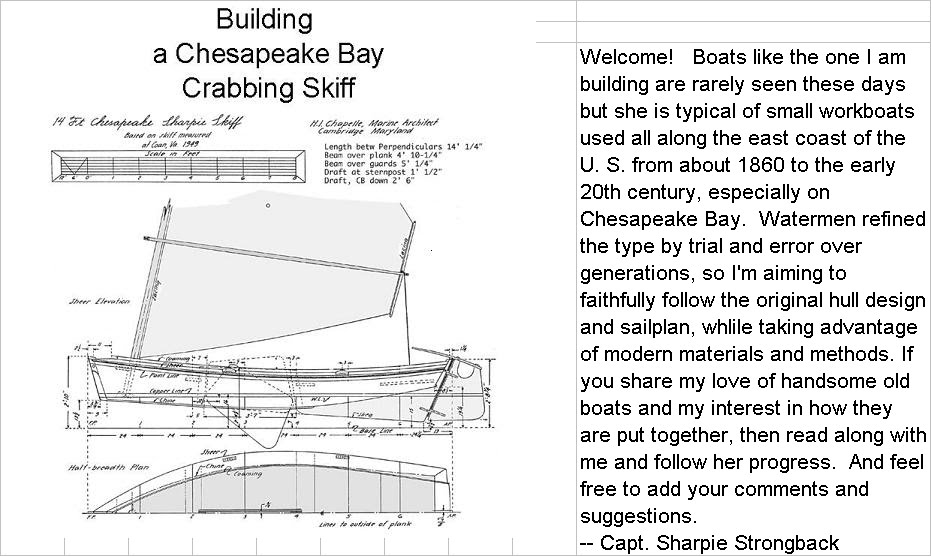
Sunday, Feb. 28: A beautiful Florida winter day. In the 40's at dawn, but 60 degrees by 10 o'clock, and I spent the afternoon working in a T-shirt for the first time since December.
Today's project was the first "keel" piece, the gripe which extends from the bow to about 9" past the aft end of the centerboard slot. The skeg will overlap it by those 9", and end right at the centerboard slot.
I made the gripe from a 1x6 nominal (really 3/4 x 5 7/16) piece of fir. I tapered it to 4" at the bow end, as the plans specify. Then I rounded off the outside edges with a router. The bottom does not have a whole lot of "rocker", curvature fore and aft, but the gripe starts at the place on the bottom where the curve is greatest. The bottom itself is only 6mm (scant 1/4") thick. So I was concerned how to bend the gripe along the bottom without screws ripping through at the aft end. My solution was to use 2 1/2" deck screws at the aft end, and screwed throuth the gripe, the bottom, and a temporary piece of 2x4 inside. That held the aft end secure. The long screws will be removed after the epoxy cures. I left the forward end of the gripe long, and pulled it down to the bottom with a piece of line lashed to the strongback, which you can just see in the picture. Once I was satisfied with the dry fit, I took the assembly apart, aplied epoxy and replaced the screws and lashings. When I install the keelson inside the boat, I will screw the gripe and keelson together . But for now I wanted the gripe to get a good epoxy bond to the bottom. So I climbed underneath and drove about a dozen small bronze screws up through the bottom into the gripe, to draw it up tight so epoxy started to squeeze out the sides. Wiping off the excess epoxy into a nice fillet completed the job. The only thing remaining will be to trim off the bow overhang.
I don't plan to cut the centerboard slot until the keelson is installed inside. Then I can cut the hole in all the pieces at the same time.
Several forces are trying to distort the hull at this stage. The chines are bent to follow the curve of the bottom, and the bottom itself is bent to its required shape, as is the gripe. Bent pieces like that will eventually get used to their shape, at least somewhat. Meanwhile they try to straighten out. The keelson inside will add to that effect. The net result is the hull is trying to flatten itself out fore and aft, which would pull the sides inward. The sides resist that pull now because of the molds the hull is resting on. But even now I can see the center of the bottom is down a little compared with the sides. When I take the hull off the molds, I will have to put in temporary cross braces to maintain the right hull width until the permanent thwarts, which will hold the sides out, are installed. But the other thing I can do to strengthen the boat fore and aft is to make the bottom of the centerboard trunk follow the design's curve, instead of following the stressed shape of the bottom. And I will also make a pattern for the designed curve for the skeg, for the same reason. Cutting the slot for the centerboard will itself help ease the stress, since that will allow the gripe and keelson to bend more easily.
OK, I realize this is more on the subject than anyone wants to read about, but bear with me: it helps me think through the next steps.
The very next step: the skeg.

No comments:
Post a Comment